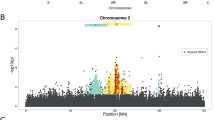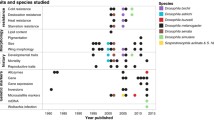Abstract
Genome-wide studies are prone to false positives due to inherently low priors and statistical power. One approach to ameliorate this problem is to seek validation of reported candidate genes across independent studies: genes with repeatedly discovered effects are less likely to be false positives. Inversely, genes reported only as many times as expected by chance alone, while possibly representing novel discoveries, are also more likely to be false positives. We show that, across over 30 genome-wide studies that reported Drosophila and Daphnia genes with possible roles in thermal adaptation, the combined lists of candidate genes and orthologous groups are rapidly approaching the total number of genes and orthologous groups in the respective genomes. This is consistent with the expectation of high frequency of false positives. The majority of these spurious candidates have been identified by one or a few studies, as expected by chance alone. In contrast, a noticeable minority of genes have been identified by numerous studies with the probabilities of such discoveries occurring by chance alone being exceedingly small. For this subset of genes, different studies are in agreement with each other despite differences in the ecological settings, genomic tools and methodology, and reporting thresholds. We provide a reference set of presumed true positives among Drosophila candidate genes and orthologous groups involved in response to changes in temperature, suitable for cross-validation purposes. Despite this approach being prone to false negatives, this list of presumed true positives includes several hundred genes, consistent with the “omnigenic” concept of genetic architecture of complex traits.






Similar content being viewed by others
Data Availability
The following supplementary data files are available on datadryad.org (https://doi.org/10.5061/dryad.m0cfxpp3r—provisional URL) and on https://figshare.com/s/579f8ef8a1b6ac74f2af: Supplementary dataset 1: Drosophila genes, N studies reporting (total and by study type), LL; Supplementary dataset 2: OF5′s, N studies reporting (total and by study type), LL1 and LLk’s.
References
Benjamini Y, Hochberg Y (1995) Controlling the false discovery rate: a practical and powerful approach to multiple testing. J R Stat Soc Series B 57:289–300
Bergland AO, Tobler R, Gonzalez J, Schmidt P, Petrov D (2016) Secondary contact and local adaptation contribute to genome-wide patterns of clinal variation in Drosophila melanogaster. Mol Ecol 25(5):1157–1174. https://doi.org/10.1111/mec.13455
Bochdanovits Z, van der Klis H, de Jong G (2003) Covariation of larval gene expression and adult body size in natural populations of Drosophila melanogaster. Mol Biol Evol 20:1760–1766
Bowman LL Jr, Kondrateva ES, Timofeyev MA, Yampolsky LY (2018) Temperature gradient affects differentiation of gene expression and SNP allele frequencies in the dominant Lake Baikal zooplankton species. Mol Ecol 27:2544–2559. https://doi.org/10.1111/mec.14704
Boyle EA, Li YI, Pritchard JK (2017) An expanded view of complex traits: from polygenic to omnigenic. Cell 169:1177–1186. https://doi.org/10.1016/j.cell.2017.05.038
Božičević V, Hutter S, Stephan W, Wollstein A (2016) Population genetic evidence for cold adaptation in European Drosophila melanogaster populations. Mol Ecol 25(5):1175–1191. https://doi.org/10.1111/mec.13464
Broer L, Lill CM, Schuur M, Amin N, Roehr JT, Bertram L, Ioannidis JPA, van Duijn CM (2013) Distinguishing true from false positives in genomic studies: p values. Eur J Epidemiol 28:131–138
Chen J, Nolte V, Schloetterer C (2015) Temperature-related reaction norms of gene expression: regulatory architecture and functional implications. Mol Biol Evol 32:2393–2402
Cooper GM, Shendure J (2011) Needles in stacks of needles: finding disease-causal variants in a wealth of genomic data. Nat Rev Genet 12:628–640. https://doi.org/10.1038/nrg3046
Fabian DK, Kapun M, Nolte V, Kofler R, Schmidt PS, Schlötterer C, Flatt T (2012) Genome-wide patterns of latitudinal differentiation among populations of Drosophila melanogaster from North America. Mol Ecol 21(19):4748–4769. https://doi.org/10.1111/j.1365-294X.2012.05731.x
Fischer S, Brunk BP, Chen F, Gao X, Harb OS, Iodice JB, Shanmugam D, Roos DS, Stoeckert CJ (2011) Using OrthoMCL to assign proteins to OrthoMCL-db groups or to cluster proteomes into new ortholog groups. Curr Protoc Bioinform 35:6.12.1-6.12.19
Franssen SU, Nolte V, Tobler R, Schlötterer C (2015) Patterns of linkage disequilibrium and long range hitchhiking in evolving experimental Drosophila melanogaster populations. Mol Biol Evol 32(2):495–509. https://doi.org/10.1093/molbev/msu320
Gerlovina I, van der Laan MJ, Hubbard A (2017) Big data, small sample. Int J Biostat. https://doi.org/10.1515/ijb-2017-0012
Goodman S, Greenland S (2007) Why most published research findings are false: problems in the analysis. PLoS Med 4(4):e168. https://doi.org/10.1371/journal.pmed.0040168
Gramates LS, Marygold SJ, dos Santos G, Urbano J-M, Antonazzo G, Matthews BB, Rey AJ, Tabone CJ, Crosby MA, Emmert DB, Falls K, Goodman JL, Hu Y, Ponting L, Schroeder AJ, Strelets VB, Thurmond J, Zhou P (2017) FlyBase at 25: looking to the future. Nucleic Acids Res. 45(D1):D663–D671
Hao LH, He QL, Wang ZS, Craven M, Newton MA, Ahlquist P (2013) Limited agreement of independent RNAi screens for virus-required host genes owes more to false-negative than false-positive factors. PLoS Comput Biol 9:e1003235. https://doi.org/10.1371/journal.pcbi.1003235
Herrmann M, Ravindran SP, Schwenk K, Cordellier M (2017) Population transcriptomics in Daphnia: the role of thermal selection. Mol Ecol 27:387–402. https://doi.org/10.1111/mec.14450
Hübner S, Rashkovetsky E, Kim YB, Oh JH, Michalak K, Weiner D, Korol AB, Nevo E, Michalak P (2013) Genome differentiation of Drosophila melanogaster from a microclimate contrast in Evolution Canyon, Israel. Proc Natl Acad Sci USA 110(52):21059–21064. https://doi.org/10.1073/pnas.1321533111
Ioannidis JPA (2005) Why most published research findings are false. PLoS Med 2:696–701
Jansen M, Geerts AN, Rago A, Spanier KI, Denis C, De Meester L, Orsini L (2017) Thermal tolerance in the keystone species Daphnia magna—a candidate gene and an outlier analysis approach. Mol Ecol 26:2291–2305. https://doi.org/10.1111/mec.14040
Klumpen E, Hoffschröer N, Zeis B, Gigengack U, Dohmen E, Paul RJ (2017) Reactive oxygen species (ROS) and the heat stress response of Daphnia pulex: ROS-mediated activation of hypoxia-inducible factor 1 (HIF-1) and heat shock factor 1 (HSF-1) and the clustered expression of stress genes. Biol Cell 109:39–64. https://doi.org/10.1111/boc.201600017
Landis G, Shen J, Tower J (2012) Gene expression changes in response to aging compared to heat stress, oxidative stress and ionizing radiation in Drosophila melanogaster. Aging-Us 4:768–789
Machado et al (in prep)
Levine MT, Eckert ML, Begun DJ (2011) Whole-genome expression plasticity across tropical and temperate Drosophila melanogaster populations from Eastern Australia. Mol Biol Evol 28:249–256
MacMillan HA, Knee JM, Dennis AB, Udaka H, Marshall KE, Merritt TJ, Sinclair BJ (2016) Cold acclimation wholly reorganizes the Drosophila melanogaster transcriptome and metabolome. Sci Rep 30(6):28999. https://doi.org/10.1038/srep28999
Morgan TJ, Mackay TFC (2006) Quantitative trait loci for thermotolerance phenotypes in Drosophila melanogaster. Heredity 96:232–242
Nielsen MM, Sørensen JG, Kruhøffer M, Justesen J, Loeschcke V (2006) Phototransduction genes are up-regulated in a global gene expression study of Drosophila melanogaster selected for heat resistance. Cell Stress Chaperones 11:325–333
Pool JE, Braun DT, Lack JB (2017) Parallel evolution of cold tolerance within Drosophila melanogaster. Mol Biol Evol 34(2):349–360. https://doi.org/10.1093/molbev/msw232
Samsa GP (2015) Has it really been demonstrated that most genomic research findings are false? Am Stat 69:1–4. https://doi.org/10.1080/00031305.2014.951127
Sarup P, Sørensen P, Loeschcke V (2014) The long-term effects of a life-prolonging heat treatment on the Drosophila melanogaster transcriptome suggest that heat shock proteins extend lifespan. Exp Gerontol 50:34–39. https://doi.org/10.1016/j.exger.2013.11.017
Schwerin S, Zeis B, Lamkemeyer T et al (2009) Acclimatory responses of the Daphnia pulex proteome to environmental changes. II. Chronic exposure to different temperatures (10 and 20 °C) mainly affects protein metabolism. BMC Physiol 9:8
Sella G, Barton NH (2019) Thinking about the evolution of complex traits in the era of genome-wide association studies. Annu Rev Genomics Hum Genet 20:461–493. https://doi.org/10.1146/annurev-genom-083115-022316
Shearer PW, West JD, Walton VM, Brown PH, Svetec N, Chiu JC (2016) Seasonal cues induce phenotypic plasticity of Drosophila suzukii to enhance winter survival. BMC Ecol 22(16):11. https://doi.org/10.1186/s12898-016-0070-3
Sørensen JG, Nielsen MM, Kruhøffer M, Justesen J, Loeschcke V (2005) Full genome gene expression analysis of the heat stress response in Drosophila melanogaster. Cell Stress Chaperones 10:312–328
Sørensen JG, Nielsen MM, Loeschcke V (2007) Gene expression profile analysis of Drosophila melanogaster selected for resistance to environmental stressors. J Evol Biol 20:1624–1636
Telonis-Scott M, Hallas R, McKechnie SW, Wee CW, Hoffmann AA (2009) Selection for cold resistance alters gene transcript levels in Drosophila melanogaster. J Insect Physiol 55:549–555
Telonis-Scott M, van Heerwaarden B, Johnson TK, Hoffmann AA, Sgrò CM (2013) New levels of transcriptome complexity at upper thermal limits in wild Drosophila revealed by exon expression analysis. Genetics 195:809–830
Vermeulen CJ, Sørensen P, Kirilova Gagalova K, Loeschcke V (2013) Transcriptomic analysis of inbreeding depression in cold-sensitive Drosophila melanogaster shows upregulation of the immune response. J Evol Biol 26:1890–1902
Vermeulen CJ, Sorensen P, Gagalova KK, Loeschcke V (2014) Flies who cannot take the heat: genome-wide gene expression analysis of temperature-sensitive lethality in an inbred line of Drosophila melanogaster. J Evol Biol 27:2152–2162
Yablonovitch AL, Fu J, Li K, Mahato S, Kang L, Rashkovetsky E, Korol AB, Tang H, Michalak P, Zelhof AC, Nevo E, Li JB (2017) Regulation of gene expression and RNA editing in Drosophila adapting to divergent microclimates. Nat Commun 8(1):1570. https://doi.org/10.1038/s41467-017-01658-2
Yampolsky LY, Zeng EL, Lopez J et al (2014) Functional genomics of acclimation and adaptation in response to thermal stress in Daphnia. BMC Genomics 15:859
Ye Z, Xu S, Spitze K, Asselman J, Jiang X, Ackerman MS, Lopez J, Harker B, Raborn RT, Thomas WK, Ramsdell J, Pfrender ME, Lynch M (2017) A new reference genome assembly for the microcrustacean Daphnia pulex. G3 (Bethesda) 7:1405–1416. https://doi.org/10.1534/g3.116.038638
Zhang J, Marshall KE, Westwood JT, Clark MS, Sinclair BJ (2011) Divergent transcriptomic responses to repeated and single cold exposures in Drosophila melanogaster. J Exp Biol 214:4021–4029
Zhao L, Wit J, Svetec N, Begun DJ (2015) Parallel gene expression differences between low and high latitude populations of Drosophila melanogaster and D. simulans. PLoS Genet 11:e1005184
Zhao X, Bergland AO, Behrman EL, Gregory BD, Petrov DA, Schmidt PS (2016) Global transcriptional profiling of diapause and climatic adaptation in Drosophila melanogaster. Mol Biol Evol 33(3):707–720. https://doi.org/10.1093/molbev/msv263
Zhou S, Campbell TG, Stone EA, Mackay TF, Anholt RR (2012) Phenotypic plasticity of the Drosophila transcriptome. PLoS Genet 8:e1002593
Acknowledgements
We thank numerous authors of the studies included into the dataset for their assistance with their data and Anant Godbole and Marc Kirschner for useful comments and criticisms.
Author information
Authors and Affiliations
Corresponding author
Additional information
Publisher's Note
Springer Nature remains neutral with regard to jurisdictional claims in published maps and institutional affiliations.
Supplementary Information
Below is the link to the electronic supplementary material.
Rights and permissions
About this article
Cite this article
Herrmann, M., Yampolsky, L.Y. False and true positives in arthropod thermal adaptation candidate gene lists. Genetica 149, 143–153 (2021). https://doi.org/10.1007/s10709-021-00122-w
Received:
Accepted:
Published:
Issue Date:
DOI: https://doi.org/10.1007/s10709-021-00122-w




